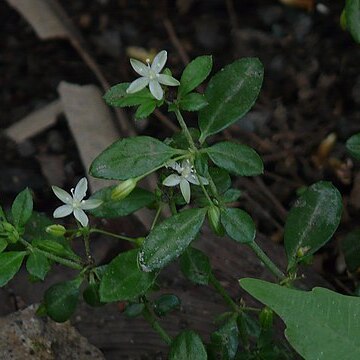Glabrous or with a few appressed hairs on the youngest parts. Stems up to 50 cm long, with internodes 1-3 cm long. Leaves opposite or in whorls of 4-6, unequal, obovate to elliptical-oblong, 1-3 cm long, 0.4-1 cm wide, acute and often mucronate at the tip, at the base gradually narrowed to a short petiole, the edges entire or obscurely serrulate in the upper half. Young leaves with a few hairs on the midrib below, the older glabrous. Flowers in groups of 3-6, on pedicels 4-8 mm long. Perianth segments 3-5 mm long, green with a brown streak outside, white or pinkish inside, the outer flat, the inner cucullate and slightly keeled. Stamens 3-5, occasionally 10. Staminodes wanting. Stigmas 3. Seeds dark brown, with small tubercles in lines, the aril less than a third the length of the seed.
Herb, annual, with stem and branches usually prostrate, to c. 50 cm long, glabrous or with simple, white, curled hairs especially on young growth. Cauline leaves not or barely petiolate but tapering gradually to the base, elliptic, ovate or obovate, 10–35 mm long, 4–13 mm wide, margin entire or obscurely dentate, glabrous or with curled simple hairs. Flowers c. 3–10 in axillary clusters; pedicels 2–7 mm long. Perianth segments 3–4.5 mm long, greenish but for scarious margins, glabrous or with a few scattered hairs. Stamens 3–5. Ovary glabrous. Styles 3 or 4, less than 0.5 mm long. Capsule 2.5–3.5 mm long, 3–4-valved, enclosed within the perianth. Seeds subreniform, c. 0.5 mm long, shiny reddish-brown, with lines of tubercles.
Much-branched, annual herb, up to 0.5 m high, often forming mats, ± glabrous, tomentose at leaf axils. Leaves opposite or in whorls of 4-6, ± elliptic-oblong, obscurely serrulate in upper half; stipules 0. Inflorescence a dense, sessile to short-pedunculate, seemingly axillary cyme. Flowers few to many at nodes, pedicellate. Perianth segments 5, free, pink, often yellowish on inner surface, margins hyaline, tip mucronate, persistent. Staminodes 0. Stamens 3-10. Ovary of 3 united carpels; stigmas 3, sessile, of hyaline papillae, persistent. Flowering time Aug.-Dec. Fruit enveloped in perianth, an ovoid, loculicidal capsule. Seeds dark brown with rows of small tubercles, funicle filiform.
An upright, spreading or prostrate very nearly glabrous diffuse subsucculent herb; branches 5–80 cm. long.. Leaves opposite or apparently verticillate, petiolate, 10–51 mm. long (including petiole of 0–5 mm.), 4–12.5 mm. broad, the blade narrowly elliptic, oblanceolate-elliptic, oblanceolate-oblong or oblong-ovate, plane, entire or denticulate, subacute or acute and obscurely apiculate at apex.. Flowers inconspicuous, greenish or pinkish white, in rather lax fascicles at the nodes, 1–15 per node, the pedicels 4.5–18.5 mm. long.. Sepals 5, free; staminodes 0–4, bifid; stamens 4–10.. Ovary of 3 united carpels.. Fruiting calyx 1.5–2.5 mm. broad, 3.5–5 mm. long.. Fig. 5/8–9, p. 14.
Herbs 10-40 cm, much branched, pilose or subglabrous. Leaves in pseudowhorls of 3-6 or opposite; leaf blade spatulate-oblanceolate or elliptic, 1-2.5 cm × 3-6 mm, base attenuate, margin with sparse teeth, apex obtuse or acute. Pedicel 5-14(-18) mm, slender. Flowers usually 2-7 in a cyme. Tepals greenish white, yellowish, or milky-colored, oblong, 3-4 mm, margin membranous, 3-veined. Stamens 3-5. Styles 3(or 4). Capsule ellipsoid, slightly shorter than persistent tepals, 3-or 4-valved. Seeds chestnut-brown, subreniform, granulose; strophiole ca. 1/5 as long as seed, claviform. Fl. and fr. almost year-round. 2n = 36.
An annual herb. This is a small thin spreading plant. It grows 10-60 cm tall. It is smooth skinned and branched and grows each year from seed. The leaves are opposite each other and 1 to 3 cm long. Sometimes the leaves are in circles. It flowers throughout the year. Flowers develop around the nodes. There are 4-6 flowers together. They are 6-12 mm long. They are greenish-white. They have a long flower stalk. The fruit is a capsule which is oval. It has 5 valves. There are many seeds. These are kidney shaped. They are 0.5 mm long.
Leaves opposite or in whorls of 4–6, unequal; laminas 5–40 × 2–18 mm., lanceolate, obovate, spathulate, elliptic-oblong to almost orbicular, entire or obscurely serrulate in upper 1/2; apex usually acute, often mucronate; base cuneate, gradually narrowed into a short pedicel; young leaves with a few hairs on midrib, glabrescent, sometimes with many appressed woolly crisped white hairs in axils and on lamina.
Decumbent or prostrate creeping herb, glabrous or with appressed hairs especially on youngest parts or in axils, with many stems up to 50 cm. long.
Seeds dark brown with rows of small tubercles; aril less than 1/3 the length of the seed.
Flowers small, whitish or cream, in groups of 1–? at nodes, on pedicels 2–14 mm. long.
Perianth-segments 5, up to 5 mm. long, free, persistently surrounding the fruit.
Ovary of 3 united carpels; stigmas 3.
A herb of moist sandy places
Fruit up to 5 mm. long.
Greenish flowers.
Stamens 3–10.
Staminodes 0.


